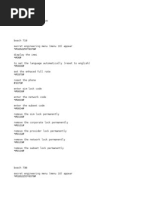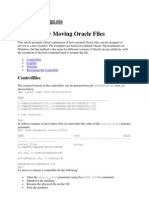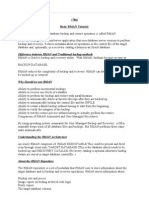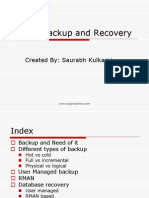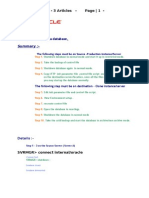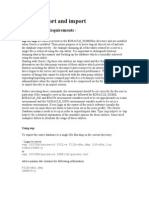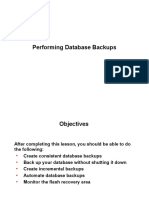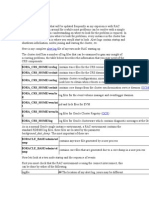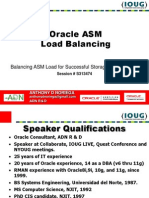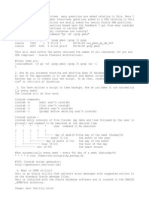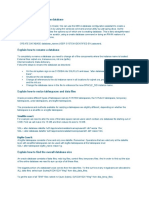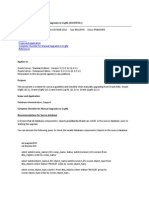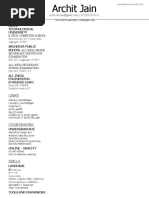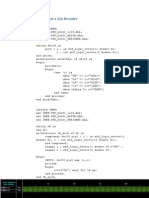Oracle Shell Scripting
Uploaded by
namratadhonde1Oracle Shell Scripting
Uploaded by
namratadhonde1Oracle Shell Scripting
This article presents some basic techniques for creating Windows batch files and UNIX/Linux shell scripts that connect to SQL*Plus and RMAN. Windows UNIX and Linux (Method 1) UNIX and Linux (Method 2)
Windows
To run an SQL script using SQL*Plus, place the SQL along with any SQL*Plus commands in a file and save it on your operating system. For example, save the following script in a file called "C:emp.sql". CONNECT scott/tiger SPOOL C:emp.lst SET LINESIZE 100 SET PAGESIZE 50 SELECT * FROM emp; SPOOL OFF EXIT; Next, create a batch file called "C:get_emp.bat" containing the following command. sqlplus /nolog @C:emp.sql The resulting batch file can be run manually, by double-clicking on it, or scheduled using the Scheduled Tasks Wizard (Start > Programs > Accessories > System Tools > Scheduled Tasks) or the AT scheduler. The method is very similar when using Recovery Manager (RMAN). As an example, place the following RMAN commands in a file called "C:cmdfile.txt". RUN { ALLOCATE CHANNEL ch1 TYPE DISK FORMAT 'C:oraclebackupDB10G%d_DB_%u_%s_%p'; BACKUP DATABASE PLUS ARCHIVELOG; RELEASE CHANNEL ch1; } EXIT; Next create a batch file called "C:backup.bat" containing the following command. rman target=/ @cmdfile.txt This command can include a catalog= entry if a recovery catalog is used. Once again, resulting batch file can be run manually or scheduled.
UNIX and Linux (Method 1)
The previous methods works equally well in UNIX and Linux environments. For example, save the following script in a file called "/u01/emp.sql". CONNECT scott/tiger SPOOL /u01/emp.lst SET LINESIZE 100 SET PAGESIZE 50 SELECT * FROM emp;
SPOOL OFF EXIT; Next, create a shell script called "/u01/get_emp.ksh" containing the following lines. #!/bin/ksh sqlplus /nolog @/u01/emp.sql The following command makes the file executable for the file owner. chmod u+x /u01/get_emp.ksh The resulting shell script can be run manually from the command line, or scheduled using CRON. For RMAN, place the following RMAN commands in a file called "/u01/cmdfile.txt". RUN { ALLOCATE CHANNEL ch1 TYPE DISK FORMAT '/u01/backup/DB10G/%d_DB_%u_%s_%p'; BACKUP DATABASE PLUS ARCHIVELOG; RELEASE CHANNEL ch1; } EXIT; Next create a batch file called "/u01/backup.ksh" containing the following lines. #!/bin/ksh rman target=/ @/u01/cmdfile.txt This command can include a catalog= entry if a recovery catalog is used. Once again, resulting shell script must be made executable using the following command. chmod u+x /u01/backup.ksh The shell script is now ready to run.
UNIX and Linux (Method 2)
UNIX and Linux environments also allow the SQL*Plus and RMAN commands to be piped directly from the command line. For example, save the following commands in a file called "/u01/get_emp.ksh". #!/bin/ksh sqlplus /nolog << EOF CONNECT scott/tiger SPOOL /u01/emp.lst SET LINESIZE 100 SET PAGESIZE 50 SELECT * FROM emp; SPOOL OFF EXIT; EOF Notice the "<< EOF" and "EOF" tags, indicating the start and end of the command being piped into the SQL*Plus executable. The shell script is made executable using the following command. chmod u+x /u01/get_emp.ksh The shell script is ready to be run manually from the command line or scheduled using CRON. The following example shows how RMAN can use the same method. Create a file called "/u01/backup.ksh" with the following contents. #!/bin/ksh rman target=/ << EOF RUN { ALLOCATE CHANNEL ch1 TYPE DISK FORMAT '/u01/backup/DB10G/%d_DB_%u_%s_%p'; BACKUP DATABASE PLUS ARCHIVELOG;
RELEASE CHANNEL ch1; } EXIT; EOF Once again, the script can be made executable using the following command. chmod u+x /u01/backup.ksh The shell script is now ready to run. For more information see: SQL*Plus User's Guide and Reference Oracle Database Backup and Recovery Reference UNIX Commands for DBAs
You might also like
- The C# Player's Guide - 5th Edition - 5.0.083% (18)The C# Player's Guide - 5th Edition - 5.0.0497 pages
- Introduction To Computer Theory by Cohen Solutions Manual80% (5)Introduction To Computer Theory by Cohen Solutions Manual198 pages
- Ap Computer Science Principles Practice Exam and Notes 202186% (7)Ap Computer Science Principles Practice Exam and Notes 2021108 pages
- Hacking The Art of Exploitation 2nd Edition Jon Erickson100% (20)Hacking The Art of Exploitation 2nd Edition Jon Erickson492 pages
- PrepTest 83 - Print and Take Test - 7sage Lsat100% (3)PrepTest 83 - Print and Take Test - 7sage Lsat46 pages
- DRBD-Cookbook: How to create your own cluster solution, without SAN or NAS!From EverandDRBD-Cookbook: How to create your own cluster solution, without SAN or NAS!No ratings yet
- Migrating and Upgrading To Oracle Database 12c Quickly With Near-Zero DowntimeNo ratings yetMigrating and Upgrading To Oracle Database 12c Quickly With Near-Zero Downtime31 pages
- Oracle To Microsoft SQL Server Migration - SQLinesNo ratings yetOracle To Microsoft SQL Server Migration - SQLines7 pages
- Installing and Creating Oracle Database 19c On Linux 7No ratings yetInstalling and Creating Oracle Database 19c On Linux 712 pages
- Steps To Be Followed To Rename or Move Control Files LocationNo ratings yetSteps To Be Followed To Rename or Move Control Files Location8 pages
- General Backup and Recovery Questions: Why and When Should I Backup My Database?100% (1)General Backup and Recovery Questions: Why and When Should I Backup My Database?16 pages
- Case Studies For Oracle Backup and Recovery PDFNo ratings yetCase Studies For Oracle Backup and Recovery PDF17 pages
- Introduction To The Oracle Server: It Includes The FollowingNo ratings yetIntroduction To The Oracle Server: It Includes The Following11 pages
- Chapter - 1: Oracle Architecture - Module 1100% (1)Chapter - 1: Oracle Architecture - Module 139 pages
- HTTP WWW Computerhope Com Unix Overview HTMNo ratings yetHTTP WWW Computerhope Com Unix Overview HTM24 pages
- Oracle ASM Load Balancing - Anthony Noriega0% (1)Oracle ASM Load Balancing - Anthony Noriega48 pages
- Explain How To Create A New Database: Smallfile Case INo ratings yetExplain How To Create A New Database: Smallfile Case I6 pages
- Oracle Goldengate Concepts and ArchitectureNo ratings yetOracle Goldengate Concepts and Architecture23 pages
- Complete Checklist For Manual Upgrades To 11gR2No ratings yetComplete Checklist For Manual Upgrades To 11gR223 pages
- Oracle 11g Data Guard Configurations by Sajid HussainNo ratings yetOracle 11g Data Guard Configurations by Sajid Hussain7 pages
- Clone An Oracle Database Using Rman DuplicateNo ratings yetClone An Oracle Database Using Rman Duplicate3 pages
- Oracle Database Mastery: Comprehensive Techniques for Advanced ApplicationFrom EverandOracle Database Mastery: Comprehensive Techniques for Advanced ApplicationNo ratings yet
- Coding With JavaScript For Dummies Everything To Know About JavaScript (2020) - 40153100% (1)Coding With JavaScript For Dummies Everything To Know About JavaScript (2020) - 40153247 pages
- NWO, Illuminati, Freemason, Occult, Bible Prophecy, Conspiracy, Secret Society, Etc. LinksNo ratings yetNWO, Illuminati, Freemason, Occult, Bible Prophecy, Conspiracy, Secret Society, Etc. Links47 pages
- Structured and Unstructured Maintenance With Example0% (1)Structured and Unstructured Maintenance With Example9 pages
- Python Programming For Beginners - A Crash Course To Learn Python and Other Recommended Coding83% (6)Python Programming For Beginners - A Crash Course To Learn Python and Other Recommended Coding86 pages
- LINUX COMMAND LINE An Introduction To Linux Command Line EnvironmentNo ratings yetLINUX COMMAND LINE An Introduction To Linux Command Line Environment174 pages
- Learn To Code HTML and CSS Develop Style Websites PDF100% (2)Learn To Code HTML and CSS Develop Style Websites PDF595 pages
- How To Use PATS Module Initialization FunctionNo ratings yetHow To Use PATS Module Initialization Function5 pages
- Chapter 1 - Introduction To Computers and C++ Programming: OutlineNo ratings yetChapter 1 - Introduction To Computers and C++ Programming: Outline12 pages
- Realme RMX3085 RMX3085L1 2024-03-10 19-00-46No ratings yetRealme RMX3085 RMX3085L1 2024-03-10 19-00-4690 pages
- Informatica Interview Questions Scenario Based PDFNo ratings yetInformatica Interview Questions Scenario Based PDF14 pages
- Software Testing - Goals, Principles, and LimitationsNo ratings yetSoftware Testing - Goals, Principles, and Limitations4 pages
- C How To Program Late Objects Version 7th Edition Deitel Test Bank100% (23)C How To Program Late Objects Version 7th Edition Deitel Test Bank4 pages
- Education: Delhi Technological UniversityNo ratings yetEducation: Delhi Technological University2 pages
- Actual4Test: Actual4test - Actual Test Exam Dumps-Pass For IT ExamsNo ratings yetActual4Test: Actual4test - Actual Test Exam Dumps-Pass For IT Exams13 pages
- Usage Notes For Receivables Invoice ServiceNo ratings yetUsage Notes For Receivables Invoice Service48 pages








